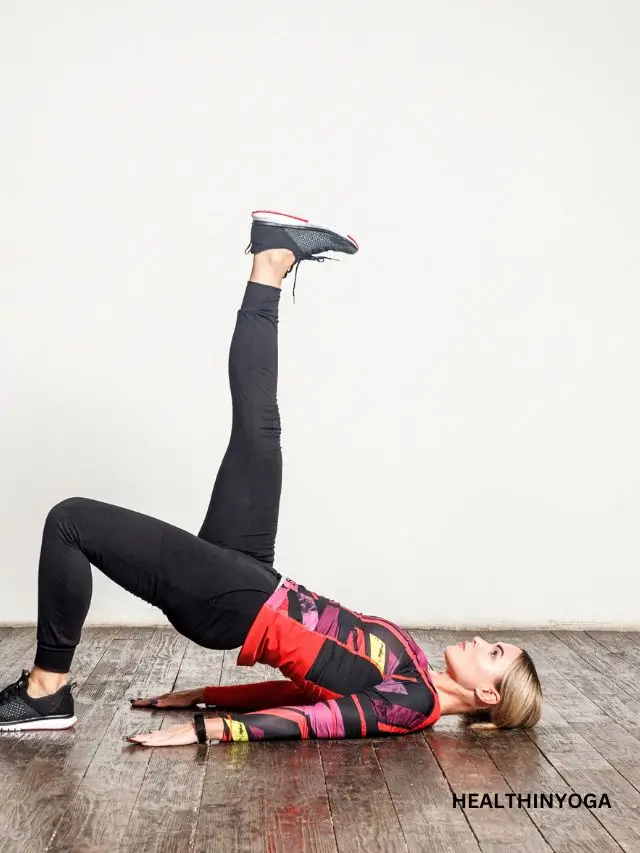Last updated on June 4th, 2024 at 06:51 pm
Introduction
One-legged Bridge Pose or Single Leg Bridge Pose is a variation of Bridge Pose. It has a lot of benefits and a few changes to the original Bridge pose. Also named as “EKA PADA SETUBANDHA SARVANASANA” in Sanskrit language. where
EKA-ONE
PADA-LEG
SETU-BRIDGE
BANDHA-LOCK
SARVANASNA -ALL\LIMB\POSE
It is a supine, one-legged intermediate-level back-bend posture easy to do for beginners. Combination of the Bridge pose and the shoulder stand pose. That tones and strengthens the core, glutes, and hamstring muscles. This variation needs lots of focus and muscle engagement adds more challenges to the daily yoga routine.
In this article we learn about one of the great variations of bridge pose and its benefits, how to do it, and contraindication of this pose.
Benefits Of One-Legged Bridge Pose
Eka pada setubandha sarvanasana has many benefits related to physical and mental health. This pose targets specific muscles like the hamstring, glutes, hip, lower back, and core. One-leg lift-up makes exercise more intense difficult and more beneficial. Here are some benefits given below read them before practicing this pose
- Strengthens the core, glutes, hamstrings, and hip muscles.
- Improve blood circulation and supply more oxygen to the muscles.
- One-legged posture enhances focus & concentration and promotes mindfulness.
- Deep stretching of the chest, spine, and hips improves the range of motion(Mobility). Help in better daily activities like walking, dancing, climbing, and jumping.
- Stimulates the abdominal organs like the kidney, liver, and pancreas.Promotes healthy reproductive system.
- Relieve the back pain and stiff back due to a long sitting position.
- A good pose for sports persons, athletes, and footballers helps linear movement.
How To Do One-Legged Bridge Pose

- Lie comfortably on the ground on your back arms at your side and palms facing down.
- Inhale comes into basic bridge pose.
- Firmly press your left foot on the ground.
- Transfer the body’s weight to the left foot.
- It helps you maintain better stability and balance.
- Inhale and raise your right leg toward the ceiling.
- Engage the core muscles and stretch the right toes.
- Bring your right leg as vertically as you can.
- Ensure core muscles are tight, and lengthen your spine.
- Lift your hips as high as possible.
- Hold the posture for 5-10 breaths or according to your body’s stamina.
- To relieve, exhale lower the right leg, and hip to the ground, and relax.
Other Variations Of The Bridge Pose
The other amazing and challenging variations of the bridge pose are
Contraindications Of One-Legged Bridge Pose
This pose is quite an advanced and challenging version of the SETU BANDHA SARVANGASNA. It requires a lot of focus, stamina, and balance it has some limitations. You must read this contraindication before doing this pose.
- A person with neck, spine, shoulder, and arm injuries does not practice this pose. A Deep stretching of the back and leg can worsen the injury and conditions.
- A person with cervical pain, vertigo, and migraine should avoid doing this pose. It may cause an increase in the pain and the pain becomes more chronic.
- Pregnant women and senior citizens should avoid this pose. It requires the engagement of abdominal muscles and a lot of balance and stamina.
- People with pain in ankles, shoulders, neck, and legs should avoid performing this pose. It can cause increased pain and worsen the condition.
- A person with weak bones or severe osteoporosis should avoid this pose. It can cause breaking the bone and injury.
Conclusion
The one-legged bridge pose is an excellent variation of the bridge pose. It is an advanced and challenging pose that can add more difficulties to your daily yoga routine. Intense stretching of the hips, legs, hamstrings, and thighs can strengthen your muscles and the spine.
This is beneficial for those who have to sit for long periods. This variation is good exercise for athletes and sports persons to help strengthen the thigh and hamstring muscles. Regular practice of this prevents the risk of injury and falling.

Honey is a certified yoga instructor with training from Patanjali Yogpeeth, Haridwar. With four years of dedicated teaching experience, she specializes in using yoga to improve spinal health, build core strength, and help people find relief from chronic pain. Her mission is to make the transformative power of yoga accessible to everyone.




